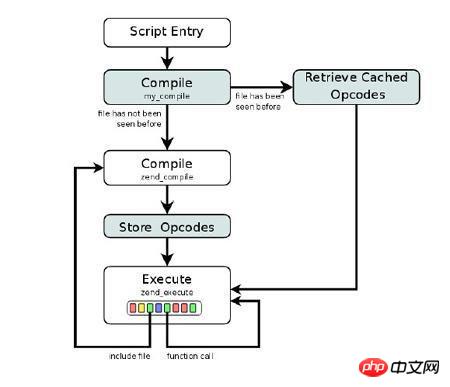
This article mainly introduces nine methods of PHP caching. Interested friends can refer to it. I hope it will be helpful to everyone.
1. Full page static caching
That is to say, all pages are generated into html static pages. The static pages are directly accessed when users visit without going to php. Server parsing process. This method is more common in CMS systems, such as dedecms;
A more common implementation method is to use output caching:
Ob_start()
*** ***Code to run******
$content = Ob_get_contents();
****Write cached content to html file*****
Ob_end_clean();
2. Partial page caching
This method is to statically cache the parts of a page that do not change frequently. Frequently changing blocks are not cached and are finally assembled together for display; this can be achieved using a method similar to ob_get_contents, or a page fragment caching strategy such as ESI can be used to cache relatively static fragments in dynamic pages. Caching (ESI technology, please Baidu, not detailed here).
This method can be used for example, on product pages in malls;
3. Data caching
As the name suggests, it is a way of caching data. ;For example, when a certain product information in the mall is requested using the product ID, data including store information, product information, etc. can be cached. At this time, these data can be cached in a php file, and the file name contains the product id to create a unique identifier; the next time someone wants to view this product, first directly adjust the information in this file without querying the database; in fact, what is cached in the cache file is a php array;
This method is used in the Ecmall mall system;
4. Query caching
In fact, this is the same idea as data caching, which is caching based on query statements. ;Cache the data obtained from the query in a file. The next time the same query is encountered, the data will be directly transferred from this file without checking the database; but the cache file name here may need to be queried. The statement is the base point to establish a unique identifier;
Caching based on time changes
In fact, this is not a real caching method; the caching technologies 2, 3, and 4 above generally use time. Change judgment; that is, you need to set a valid time for the cached file. Within this valid time, the same access will first fetch the contents of the cached file. However, if the set cache time is exceeded, the data needs to be retrieved from the database and produced. The latest cache file; for example, I set the homepage of our mall to be updated every 2 hours;
5. Cache according to content changes
This is not independent either Caching technology needs to be used in combination; that is, when the database content is modified, the cache file is updated immediately;
For example, in a shopping mall with a large flow of people and many products, the product table must be relatively large, and the pressure on this table It is also relatively heavy; we can cache the product display page;
When the merchant modifies the product information in the background, click Save, and we will update the cache file at the same time; then, when the buyer accesses the product information When accessing a product, you actually access a static page without accessing the database;
Just imagine, if the product page is not cached, then you have to check the database every time you access a product. If there are 10 With tens of thousands of people browsing products online, the server will be under great pressure;
6. Memory caching
When it comes to this, the first thing that everyone may think of is Memcached; memcached is High-performance distributed memory cache server. The general purpose of use is to reduce the number of database accesses by caching database query results to increase the speed and scalability of dynamic web applications.
It caches the information that needs to be cached into the system memory. When the information needs to be obtained, it is retrieved directly from the memory; the more commonly used method is the key–>value method;
connect($memcachehost,$memcacheport) or die ("Could not connect"); $memcache->set('key','缓存的内容'); $get = $memcache->get($key); //获取信息 ?>
7. Apache cache module
After apache is installed, it is not allowed to be cached. If an external cache or squid server requires web acceleration, it needs to be set in httpd.conf. Of course, the premise is that the mod_cache module must be activated when installing apache.
When installing apache: ./configure –enable-cache –enable-disk-cache –enable-mem-cache
8, php APC cache extension
Php has an APC cache extension, which is php_apc.dll under windows. You need to load this module first, and then configure it in php.ini:
extension=php_apc.dll apc.rfc1867 = on upload_max_filesize = 100M post_max_size = 100M apc.max_file_size = 200M upload_max_filesize = 1000M post_max_size = 1000M max_execution_time = 600 ; 每个PHP页面运行的最大时间值(秒),默认30秒 max_input_time = 600 ; 每个PHP页面接收数据所需的最大时间,默认60 memory_limit = 128M ; 每个PHP页面所吃掉的最大内存,默认8M
9, Opcode cache
We know that the execution process of PHP can be shown in the following figure:

First the PHP code is parsed into Tokens, then compiled into Opcode code, and finally the Opcode code is executed and the result is returned; therefore, for the same PHP file, its Opcode code can be cached the first time it is run, and the Opcode code can be executed next time When viewing the page, it will directly find the opcode code in the cache and execute the last step directly, without the need for intermediate steps.
Summary: The above is the entire content of this article, I hope it will be helpful to everyone's study.
Related recommendations:
php determines whether the required parameters in the function exist
PHP (iterative recursion) Detailed explanation of realizing unlimited classification
php supports Chinese file download
The above is the detailed content of Nine methods of PHP caching. For more information, please follow other related articles on the PHP Chinese website!




